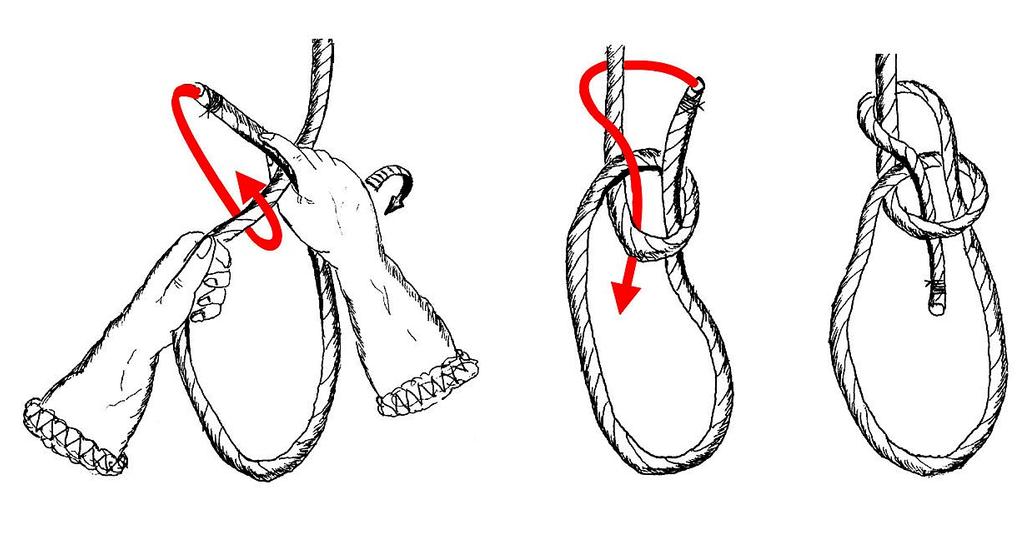Tie This 'Lifesaving' Bowline in Seconds - the easy way!
by John Jamieson on 2 Jul 2014

BowlineStepsPanel Captain John Jamieson
http://www.skippertips.com
It was another perfect November day for frostbiting--until that 25-knot gust struck out of nowhere! With no time to release the mainsheet, I flipped the boat in shallow water, about two hundred yards from shore.
The tiny 14-footer rolled 180 degrees before planting its mast firmly into the muddy bottom of Charleston Harbor. The boat resisted every attempt to right her. As tempting as that lee shore looked, I decided to stick with the boat and wait it out. It turned out to be a good decision.
I pulled myself up onto the boat's whale-belly bottom, wrapped one arm around the centerboard, and waved with the other. Since I was well outside the channel proper, no one saw me. And it was getting colder by the minute. Matter of fact, I was quickly losing feeling in my submerged legs. I prayed that help would arrive soon.
Finally I saw them, riding that glorious white thoroughbred with a flaming-red racing stripe. Aye, with a bone in her teeth she was steaming dead for me! The Coasties had arrived. They came alongside and asked me how I was. 'Hi guys, thanks for stopping by!' was about all I could mutter between blue lips and chattering teeth.
They tossed me a hawser and I dove beneath the hull. Of course, there could only be one knot to tie around the boat's mud-sucking spar: the bowline. They hauled me aboard and stowed me down in the warmth of the cabin to thaw. Gazing through the porthole, I saw the coxswain take a strain, and my lovely righted herself. Free at last!
The knot I used, the bowline, is the one I consider the king of knotland. And the bowline shown in the illustration is the fastest and most secure I have used aboard sail and power vessels. Grab a piece of line now and tie along with the steps and illustration below.
Use This 'Knot-Tying' Tip
Take a look at the illustration. Notice how we face the standing part of the line. Bowlines are tied in one of two ways: you will either face the standing part or face away from the standing part. That's a critical point. You can tie a bowline either way, but to tie the bowline as shown, you must face the standing part of the line.
If you are tossed a line, you will face the standing part. Or, if a line comes off a fixed point like a cleat and you need to tie a bowline in the end, you can position yourself to face the standing part. (there are dozens of other ways to tie the Bowline, but I believe this is one of the easiest).
Follow these three steps along with the illustration:
1. Bitter end on top. Start the bowline as shown. Face the standing part. Hold the standing part with your non-dominant hand. With your other hand, loop the bitter end and place it on top of the standing part. Hold it in place with your palm facing down and your thumb underneath, as shown in the first illustration.
2. Twist away. Keep the line held in your non-dominant hand a bit slack (notice in the first illustration, the non-dominant hand allows slack in the standing part). With your other hand, twist your wrist away from you and at the same time, pass the bitter end under the bight to form a small loop (first and second illustration).
3. Loop around and through. Pass the bitter end around the standing part and back down into the small loop. Keep the bitter end 4 to 6 inches long. Work the slack out of the knot to help prevent it from spilling (untying) when shocked.
Practice tying this bowline until you can do so blindfolded--in five seconds or less. If you really want to test yourself and prove you're and 'old salt', tie behind your back.
Sail safer this sailing season on the waters of the world--wherever you choose to sail or cruise!
John Jamieson (Captain John) with 25+ years of experience shows you the no-nonsense cruising skills you need for safer sailing worldwide. Visit his website at Skipper Tips and sign up for his highly popular Sailing Tip of the Week. Discover how you can gain instant access to hundreds of sailing articles, videos, FREE e-Books and much more!
If you want to link to this article then please use this URL: www.sail-world.com/123961